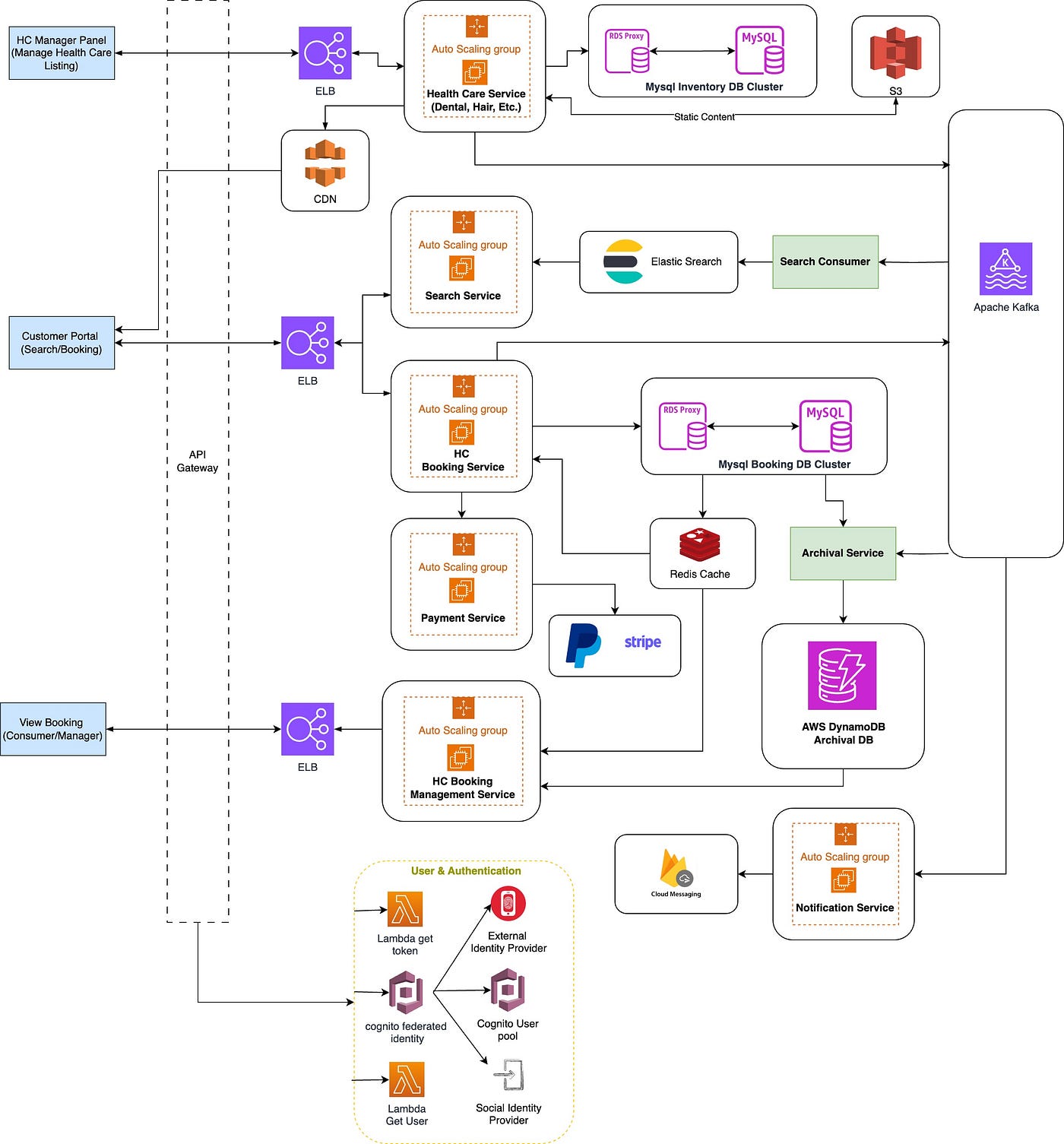In Part 1, we explored the story and architecture of our healthcare booking platform. Now, let’s dive into the technical implementation that makes it all possible.
This article breaks down the core technical components of our platform built with Django REST Framework and React.js. We’ll examine the key processes, from real-time search and booking management to data synchronization and scaling strategies, providing insights for architects and developers building similar systems.

Backend Architecture
Framework:
- Django REST Framework
- Handles API endpoints and business logic
- Provides robust serialization and validation
- Manages authentication and permissions
Database Layer
- MySQL Clusters for transactional data
- Redis for caching active bookings
- DynamoDB for archival storage
- Elasticsearch for search functionality
Frontend Architecture
- Framework: React.js
- Component-based UI development
- Redux for state management
- React Query for API data fetching and caching
Key System Processes
1. Healthcare Provider Listing Management
Technical Flow:
- Provider submits listing through React frontend
- Django REST API validates and processes the data
- Data is stored in MySQL Inventory Cluster
- Kafka event is triggered for search indexing
- Search Consumer updates Elasticsearch index
- Static content (images, documents) stored in S3
Key Technical Considerations:
- Implement optimistic locking for concurrent updates
- Use transaction management for data consistency
- Implement caching for frequently accessed listings
- Handle image resizing and optimization
2. Search Implementation
Technical Flow:
- User initiates search from React frontend
- Search request hits Django endpoint
- Django service queries Elasticsearch
- Results are filtered and ranked based on relevance
- Paginated results returned to frontend
Search Features:
- Fuzzy matching for typo tolerance
- Geo-location based sorting
- Faceted search capabilities
- Real-time result updates
3. Booking Process
Technical Flow:
- User initiates booking
- Django creates booking record in MySQL Booking Cluster
- Booking details cached in Redis
- Payment integration with Stripe
- Real-time updates via WebSockets
- Archival process moves completed bookings to DynamoDB
State Management:
- Pending → Payment Pending → Confirmed → In Progress → Completed
- Each state change triggers appropriate notifications
- Redis cache invalidation on state changes
4. Data Synchronization
Real-time Updates:
- WebSocket connections for live booking updates
- Kafka streams for search index synchronization
- Redis pub/sub for cache invalidation
Batch Processing:
- Nightly archival of completed bookings
- Periodic cleanup of expired bookings
- Regular cache warming for popular listings
Performance Optimizations
1. Caching Strategy
- Redis for active bookings
- AWS CDN for static content
- Application-level caching for common queries
- Browser caching for frontend assets
2. Database Optimizations
- Read replicas for high-traffic queries
- Connection pooling
- Query optimization and indexing
- Partitioning for historical data
3. Search Optimization
- Elasticsearch index optimization
- Search result caching
- Incremental index updates
- Query result pagination
Security Implementation
1. Authentication
- JWT-based authentication
- Role-based access control
- Session management
2. Data Protection
- Field-level encryption for sensitive data
- TLS for data in transit
- Audit logging for sensitive operations
- GDPR compliance measures
Monitoring and Maintenance
1. System Monitoring
- Application performance monitoring
- Database query monitoring
- Search performance metrics
- Cache hit/miss ratios
2. Error Handling
- Centralized error logging
- Automatic retry mechanisms
- Fallback strategies
- Circuit breakers for external services
Scaling Considerations
1. Application Scaling
- Auto-scaling groups for services
- Load balancer configuration
- Stateless application design
- Horizontal scaling capability
2. Database Scaling
- Read replica management
- Connection pool optimization
- Sharding strategy
- Backup and recovery procedures
The system is designed to handle high loads while maintaining data consistency and providing a smooth user experience for both healthcare providers and customers.
Part 1: Building a Scalable Healthcare Booking Platform (Part 1): A System Story
Part 3: Building a Scalable Healthcare Booking Platform (Part 3): Listing Searching Mechanism
Part 4: Building a Scalable Healthcare Booking Platform (Part 4): Role-Based Access Control